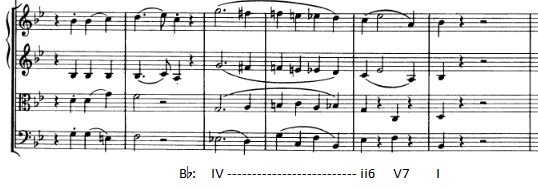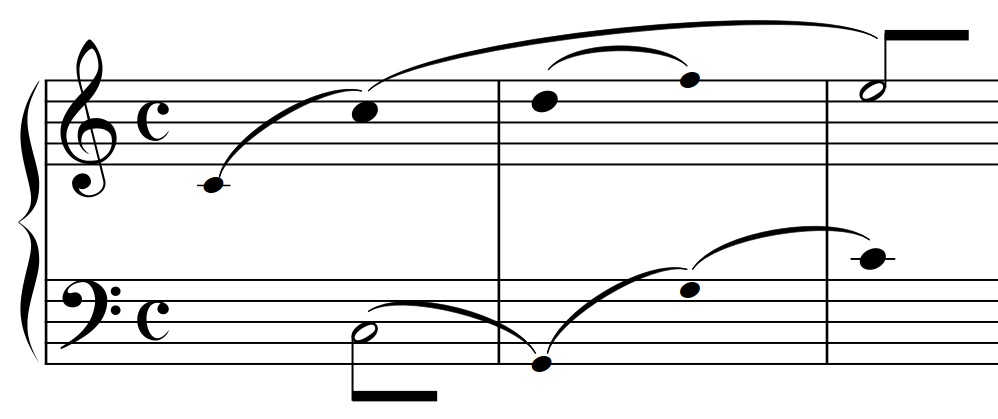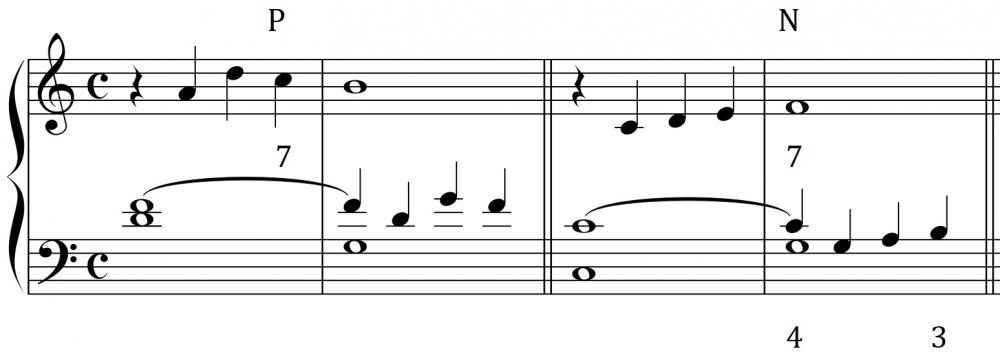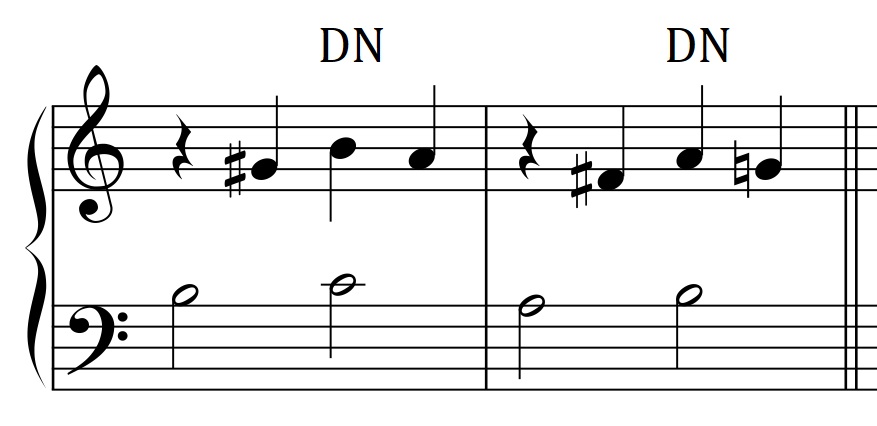
johnbucket
Members-
Posts
828 -
Joined
-
Days Won
35
johnbucket last won the day on October 6 2017
johnbucket had the most liked content!
About johnbucket

- Birthday January 2
Profile Information
-
Gender
Male
-
Occupation
Student
-
Interests
None
-
Notation Software/Sequencers
Sibelius 7
-
Instruments Played
Pianoforte
Recent Profile Visitors
25,082 profile views
johnbucket's Achievements
-
therealAJGS started following johnbucket
-
Good attempt, though not without very many problems. You have a reasonable grasp on the harmony and stock phrases of the style, but there's much to improve. Unfortunately, I don't have the time to look at this at any great detail.
- 3 replies
-
- string quartet
- mozart
-
(and 2 more)
Tagged with:
-
I have listened to this through a handful of times; the piece reminded me of Scriabin's Prelude in C major from his op. 11 set (embedded at the bottom). I really like the initial figuration, which you spun out for a considerable span of time whilst maintaining my interest, but I'm sorry to say that I didn't care much for the section where the texture becomes syncopated between the hands. To address your concerns: the main weakness in the large-scale structure, to my ears, can be located in where the music breaks off into the F-sharp major section (after which you introduce the textural shift mentioned above.) In my hearing, the main climax of this piece is the glorious affirmation of E major in bar 67. Whatever comes after that sounds to me like a dying away, and being the classically-trained listener that I am (classical with a small c), I was expecting a reprise of the initial tonality and material, perhaps modified in some respects, or even something that is recognisably a version of the opening material. That being said, I don't think the fact that there isn't a governing tonality (or 'home key') is a problem in itself, as other members have pointed out; the question is how you can end satisfactorily in that different tonality, whatever that may be. The problem I had with the overall structure is that you have an influx of energy from about bar 87 onwards with the (re-)introduction of F-sharp major harmony. I was led to expect this F-sharp harmony to be transient, probably because this was how it functioned in bar 62. Instead, you stamp your foot down and go, nope, there's going to be a section in F-sharp major. Fair enough. But I was still expecting the music to move at bar 95, where the texture changes, and even at bar 110--i.e., I was happy to accept this section as a parenthesis of sorts--but this expectation was never fulfilled. I suspect that is what made the reprise of the original material in bars 111 et seq. sound so flabby and formulaic to me. (The insensitive mock-up didn't help things.) I think you would do well to re-write a version of this piece that maintains the opening texture throughout--the shifts in tonality and rhythmic accents provide more than enough momentum and interest to my ears--and see what would come out of that as an exercise. Try to bring the music back to the opening tonality and figurations from bar 67; I think you can afford to keep everything up to bar 86. You may well find that the product of that more aesthetically appealing than what you have now. Let me split my further comments as they pertain to two different dimensions of the music, harmony and [surface] rhythm, although the two aren't always easy to separate (and it isn't clear to me whether it's advantageous to do so). I love the idea of the music getting ever flatter. You nearly traverse the entire circle of fifths, and I think the introduction of flat(ter) elements was well-paced. (I disagree that the initial tonality is necessarily in A minor, incidentally: to my ears, it begins incontrovertibly in C major, although what the governing tonality is after that--F Lydian/major?--and where the substitution of one tonal framework for the other happens aren't as clear.) You make good use of flat submediant relations (i.e. I-bVI), and that's how you allow for this drive towards E major as the climax, and I didn't mind the unresolved ninths as much as I thought I would, with the effect that I hear a certain haziness between the harmony of the root and the harmony of the scale degree above that root; e.g. in bars 40-44, there's a shift in focus from C-flat major to D-flat major, and it's not easy to place it, although it happens somewhere within bars 41-42. (I think you should insert pedal markings to make your conception of the harmony clear, although I like the idea of leaving it to the discretion and musicianship of the performer.) The harmonic reinterpretation of bar 23 in bar 29 was effective, since you subverted the expectation of a repeat through this harmonic shift. I find it interesting that I hear B-flat as the chord tone in bars 25 and 26, whereas I hear G as the chord tone in bars 31-33. (By analogy, it should be A-flat.) That being said, it's not hard to explain. I heard the main harmonic motion as that between F major and B-flat major-ish with an added sixth (or I-ii6/5; take your pick) up to bar 22, so I wasn't inclined to hear the return of F without an accompanying F in the bass. On the other hand, the shape of the figuration in bar 30, which emphasised G and E-flat as the consonant notes, the insistence on E at the top of the figuration in bars 31-33 and the fact that this was repeated for three bars led me to hear this as an E-flat major chord in second inversion that was nonetheless tense; i.e. I was waiting for the arrival of E-flat in the bass. I wonder if it might be more effective (if less subtle an effect) to change the figuration from Bb-A-F to A-Bb-F in bars 25 and 26. I'm not sure if I was convinced by the weak harmonic transition from bars 47-50; essentially, you've introduced the notes of the natural E-flat minor scale by bar 48, and although this anticipates the following E-flat minor, it doesn't make that E-flat minor sound like an arrival, even though it feels like it should be one because of other events (the introduction of the scalar motif [i.e. Eb-F-Gb in the left hand, the introduction of new material, the start of a new period [bars 51-58]). I wonder if a plain bII-i would have worked better. In any case, I do like this play between E-flat major, E-flat minor and E major. (Speaking of which, I think you could have done more with that scalar motif. Perhaps, if you did rewrite this as an exercise, you could combine this scalar motif with the opening material for the reprise?) In general, your sense of harmonic pacing is good, although I found the phrase structure somewhat distended at times. Cases in point: bars 10-11, 14-16, 23-26, 29-33, 40-44, 47-50. In contrast, I felt that the built up to the E major wasn't long enough. I think that's because we get so little of the flat 'pre-dominants'--only bars 65-66--whereas just an additional bar of some other flat pre-dominant--say, B diminished (i.e., 'ii[7]')--or even D minor (either root or first inversion) would have helped. Or maybe it's not a matter of length, and what I really want is increased rhythmic activity leading up to this climax. (It is arguable whether the E major in bar 67 is a tonic or a dominant; I personally hear a dominant-like quality to it yet I wouldn't say that A major is the governing tonality at that point. But it isn't really in the Phrygian or the Mixolydian, either. I would prefer to refer to a harmony like this as simply E dominant.) I think you have a predilection for two-bar units and you shy from breaking this evenness, and that saps the vitality of the music somewhat. This discussion allows me to segue into rhythm. I love how you constantly shift the patterns. That being said, your preference for metrical regularity restricts what you can do somewhat. The repetition of bar 3 into a two-bar unit is anodyne; why not try changing bar 4 into a 2/4 bar (you do implicitly change metre from compound duple to simple triple from bars 1-2 to bars 3-4), with the r.h. figuration thus: A-D-C-E-B-D-G-C? That would break the monotony of having every bar here begin with C-B, while throwing off the listener, too. I think you should strive to make the piece even less regular than it is. And for bars 8-10, why sit on the bass A with the same figuration? I think you could easily excise one bar, and change the bass to A (and the figuration correspondingly) at some point in bar 9 (perhaps the fifth quaver?); this would reinforce the impression of compression given in bar 8. Likewise, I don't think the unexpected accent in bar 16 provides sufficient interest, let alone momentum, in this passage. I think you'd want to reserve stasis for special moments; as it is, the frequent recurrence of such moments of flatness comes across more as uninspired vamping than anything--sort of like an improviser stalling for time. There's probably more I could say, but I've spent too much time on this as it is.
-
https://www.amazon.com/Classical-Form-Functions-Instrumental-Beethoven/dp/019514399X https://www.amazon.com/Elements-Sonata-Theory-Deformations-Late-Eighteenth-Century/dp/0199773912 Seriously, the people who would do it really well don't have the time to spend on this site.
-
jrcramer started following johnbucket
-
Liam Doyle started following johnbucket
-
Help me for writing Nocturne and Waltz
johnbucket replied to Muhammadreza's topic in Composers' Headquarters
There you go; you are restricting 'genre' vis-à-vis music to its popular meaning, which, as it so happens, classifies music at a much larger scale, and are unaware that the term itself has a much wider range of uses and associated scopes and concepts. But good. I wouldn't have replied if you hadn't contradicted me so baldly and, as it turns out, without good reason, but at least we agree on something now--superficially as the case might be. Espero que tengas un buen día. -
Help me for writing Nocturne and Waltz
johnbucket replied to Muhammadreza's topic in Composers' Headquarters
You either don't understand or know what a genre is or are assuming a very narrow definition of it. EDIT: Here's some text which I hope may be of some help. From Jim Samson's 'Chopin and Genre' (1989) in Music Analysis, Vol. 8 No 3: 'Genres might be compared with stylistic norms or formal schemata.* All three are abstractions - 'ideal types' - but abstractions whose basic principles flow from actual musical works. All three are based on repetition, codifying past repetitions and inviting future repetitions. Because of this all three can help to regulate the area between content and expression within an individual work, while at the same time mediating between the individual work and music as a whole. Given these parallels and given too the obvious importance of the concepts as agents of communication, it seems worth exploring a little more closely the relationship between genre, style and form, and in particular the differences in their mechanisms. In its widest sense, especially as presented in some popular music theory, genre is a more permeable concept than either style or form, because a social element participates in its definition, and not just in its determination. In this broad understanding of the term the repetition units that define a genre, as opposed to a stylistic norm or a formal schema, extend beyond musical materials into the social domain so that a genre is dependent for its definition on context, function and community validation and not simply on formal and technical regulations. Thus a genre can change when the validating community changes, even where the notes remain the same. The social dimension can extend, moreover, to the function of genre within the validating community. As several authors have noted in literary and musical theory, a genre behaves rather like a contract between author and reader, composer and listener, a contract which may of course be broken. It is above all in the incorporation of this social element as to definition and function that genre theory in literary and musical studies has developed beyond its presentation in early twentieth-century poetics, notably in Russian Formalism.' […] 'Chopin's project and achievement was to give generic authority to the free- ranging devices of an emergent repertory, crystallising the meanings of some existing titles, transforming the meanings of others and devising new titles to meet new generic requirements. In each case there is a measure of consistency in the semiotic relation of the title to the formal and stylistic features of the piece. As we know, the "sign" is bipartite, and both parts are essential. The title is integral to the piece and partly conditions our response to its stylistic and formal content, but it does not create a genre. Equally a taxonomy of formal and stylistic devices will not of itself establish a consistent basis for generic differentiation. It is enough to consider the substantial overlaps between Chopin's genres in this respect. Without the title we might have difficulty classifying even some of the nocturnes. It is the interaction of title and content which is important.' -
Help me for writing Nocturne and Waltz
johnbucket replied to Muhammadreza's topic in Composers' Headquarters
There is no set nocturne form; it's also difficult to pin down general characteristics, although one can try (and many have). One might even say that there are sub-genres of nocturnes. I suggest you take one of the early nocturnes and write a nocturne based off it. -
I'm afraid I don't have the time or the will to review this in-depth, but I've taken a quick listen through it and liked the general style. Juste un seul petit bémol: I'm not sure what's going on in your title, but it's Sonata-Fantasia in Italian, Sonate-fantaisie in French and Sonate-Fantasie in German. I would personally go with Sonata-Fantasy, myself.
-
[Open discussion] Young Composers Magazine
johnbucket replied to Maarten Bauer's topic in Young Composers Magazine
While I definitely approve of this in principle, I am concerned about how ambitious it seems to be. 32 pages of content is quite a bit! I wonder if it might be more propitious to use a rolling-article system instead, where different contributors could release new articles as and when it suits. I would be happy to contribute an article, once it is clear which area needs more contributors, and to edit in general. I could do with the practice. However, it must be said that I'll be very busy with work until late next month, and even more so once I start what the Americans call 'grad school'. -
I found this movement much better than the first. I love the tonal scheme in the scherzo: a to d to E-flat//B-flat to a. The extensive use of and focus on D minor in the recapitulation was a clever touch, I thought, and the return of A minor comes across as a sting-in-the-tail. Definitely loving how you have managed to transform a conventional point of return into something so witty. Certainly, it makes sense to have the trio in F major, the submediant of A minor, given the emphasis on the Neapolitan (also the rising fifths from E-flat to B-flat to F [and in the next movement, to C!]); even then, F is so strongly highlighted in the main theme. And, of course, A minor is the submediant of C major! I love how you feigned the return to the scherzo in the middle of the trio, but it is a sleight of hand that works only once; I know why it's there twice (because you repeat the 'second half' of the trio literally), but the structure of the trio is flawed, since you already have a 'rounded binary' that closes in F for the 'first half' (with no repeats or cadential articulations, and the ending of the A section and the very brief bridge being run-on? That could work as a clever play with conventions, but ... I won't go so far as to say that the entire trio section comes across as a misreading of how Beethoven repeats the trio twice, with the 'dance' interspersed, in the 'dance' movements of some of his symphonies, e.g. nos 6 and 7 ). If I were to do it, I'd expand the 'first half' here (i.e. trio proper), and continue from the feign in the 'second half' here as if I were repeating the 'first half' (trio proper) again, but veer off subtly and prepare for the return of the scherzo. Other advice: I would have loved to hear the rhythmic elements more carefully incorporated into/delineated by the structure, because the syncopations appear to be all over the place, although that's fine in its own way, and I think some of the sections could do with some tonal tightening, but I'm not prepared to give any advice on that front without having analysed the music first with the aid of a score. But it's good work as it is. Again, my quibble is that the weaknesses are plainly audible to anyone who's put in their time for analysis; you might want to consider picking that up further to help with composing this kind of stuff. Some 'peccadilloes': you really should get rid of the parallel octaves and consecutive (unequal) fifths around 0:37 to 0:38 (the two bars with C-Ab-F and Bb-G-Eb in the bass), and wherever else. Well done; congratulations!
-
This is looking very promising. Do you reckon it'd be worth putting in some samples of what these techniques sound like or linking an online resource (website/Youtube channel) that has them?
- 8 replies
-
- 2
-

-
- extended techniques
- strings
-
(and 1 more)
Tagged with:
-
This piece is incomplete, conceptually, but because it's going to stay at this stage for much of the foreseeable future, I have decided to upload it here. I suppose it is best described as a postmodern parody of Beethoven's late quartets, but make no mistake: it is serious music.
-
Beethovenian Symphony Movement for Piano
johnbucket replied to Sonataform's topic in Piano Music, Solo Keyboard
Matthew, Let me preface my (brief) comments. I thoroughly approve of and encourage this sort of stuff. Like languages, the best way to learn music is by actively practising it, whether through performing, composing, analysing or simply listening engagedly. So long as you have learned something from composing this piece and you are confident of you artistic agency in your creation, you have done something worthwhile. Never pay heed to those who refuse to take stylistic composition seriously, those who attempt in vain to resurrect the dead horses of modernist conceptions of originality and authenticity and drape them around themselves, as if the rotting carcasses and accompanying swarms of flies could mask the sight that the emperor has no clothes! It's precisely these people who don't want to understand, and possibly even dislike, older music. Now on to your music. I've only listened through once, and because I'm not at liberty to give you detailed feedback, especially without the aid of a score, my comments will necessarily be short and general. You seem to have developed a fair grasp of the harmony, melodic figurations and textures of the period. That being said, there were some slip-ups (e.g. inexplicably abrupt modulations in the development, or the superimposition of D-C# over melodic B-G-E-C# in the bass at the medial caesura). While this was stylistically reminiscent of Beethoven as a whole, bits of it were rather Schubertian, but that's not a bad thing. What I found disappointing was that you don't seem to demonstrate enough awareness of how classical music functions at the middle- and large-scales. Take your first 'theme', for example. Are you aware that what you have here is very unusual for a first theme? It's essentially a 'cadential' phrase (i.e. what you expect to be the second half of a theme, and its recognisably cadential despite how persistently and artfully you evade the strongly implied perfect cadence) stated four times, with the last two bars repeated once before the true cadential bit comes in. I appreciate how you subtly delay and build towards this first perfect cadence, but the 'theme' strikes me as unidiomatic nonetheless. I also felt that there wasn't control over the pacing of form or the rhetoric (the recapitulation wasn't prepared for), and surprising elements or events don't often have an obvious musical logic to them, when it should be in this (early/late Beethovenian) style. I'm ready to illustrate and defend what I mean in analytical terms, so feel free to ask. However, it will be a while before I can respond thoroughly. -
Dear Dan, You will have to excuse me if I am brief or sloppy in my responses, but I will try my best to answer your questions. This is, of course, a matter of context. The matter of the fact is that, in this style, iii does not usually appear as an intermediary harmony in the major, and if we make certain reasonable assumptions, as Schenker did and Lerdahl and Jackendoff do, about how we listen to tonal music (again, whether this is culturally acquired - which is more likely - or psychologically-innate is a battle that does not concern us here in the least), such as the hierarchical priority of tonic harmony and the implicit filling in of missing tones, one would tend to parse the sonority as I6 without the root (which we nonetheless fill in with our ear) rather than iii without a fifth. Put it this way: there is incomplete information, and our mind tends to the more likely possibility (I6) over the less likely one (iii) - this despite the fact that the fifth of iii is generated in the overtones (these overtones don't count in harmonic parsing, just as minimal variations in pitch contour or vowel height should not hinder us from understanding another person's spoken English). Put another way, we learn to interpret tonal music within a certain framework of tonal syntax and grammar, and within this system, I6 is privileged over iii. As an analogy, try to think: why did it rain this afternoon? We would think it would be because moisture has evaporated from the ground into the air and has condensed into clouds, and/or because warm and cold air masses had met - in short, all-natural causes. But it may well be because of cloud seeding. The point is that we would tend to attribute our imagined rain to the former over the latter should we lack the additional informational, an announcement by the relevant governmental agency - or, returning to the matter at hand, the fifth of iii - that would have incontrovertibly settled the dispute. Mutatis mutandis, this holds for the minor, too. I'm sure those who actually know a thing or two about psychology and evolutionary biology would be able to put this against a more general backdrop and provide better allegories. However, that is not to say that it may not sometimes make more sense to interpret this dyad (or other ambiguous cases) as iii or III over I6 or i6. Take a look at the following extract from the D minor invention: Leaving aside the second harmonies of each iteration of the sequence (which I have understood as vii7 and vi, because the motif is harmonised at the outset such that we hear the semiquavers falling on the second and third quavers as accented passing notes, although that means that the implied seventh in the 'vi' bar is resolved in the upper voice - but then again, we don't have to be so pedantic and enslaved by dichotomies, and so we could view the B-flat as a 'passing resolution' of the C on the lower part's way to A), we are faced with the question of reading the boxed harmonies as one or the other (unfortunately, harmonic analysis does have a tendency to be binary). In my view, the former is the better reading as it continues the sequence of descending fifths initiated earlier (part of which you can see in this example); this is despite the fact that the presence of the third below these roots would seem to argue for the latter reading. In addition, because the peaks of the upper voice are so prominent (F5 and E5, respectively), one would have to incorporate them into the harmonic analysis, but they are 'unresolved' sevenths in the latter reading - we would either have to mentally prolong the F over the next bar, where it becomes a ninth, or we would have to take an implicit resolution to E for granted (even if the analogue to this doesn't work when this E becomes the next 'seventh'). Of course, in the former reading, these thirds below the root in the lower part become part of an extended neighbour figuration to the tonic (i.e. G-A leads to B-flat in the first case). But then again, it's possible to capture the ambiguity of this harmonic progression by saying that the latter reading is shadowed within the former. As for the second part of your question, it depends on whom you ask. Schoenberg, I believe, would always see diminished chords on the leading tone as dominant chords without the root, even if the fifth (scale degree 4) or indeed the diminished seventh (flat scale degree 6) is present. Indeed, the two chords perform such similar functions anyway (very much unlike I6 or i6 and iii or III), so this collapse in distinction doesn't matter too much in the larger picture. But I wouldn't conflate the two, and neither would I read F-A, in the key of C major, as anything other than IV, unless it is absolutely important to get the point across that a D is strongly implied. So yes, I6 or i6 and iii or III would be the exception. E5 against Bb3, third crotchet. Again, we need to return to the idea of there being a hierarchy of harmonies in tonal music. It would be extremely tiring, not to mention unilluminating, if we were to treat and understand every single change in harmony as being equal to each other. I will explain this by means of analogy, although I admit that there are pitfalls. The go-to example would be linguistics. I take it that you are a native speaker of English? Take a look at this opening sentence: 'It was the best of times, it was the worst of times, it was the age of wisdom, it was the age of foolishness, it was the epoch of belief, it was the epoch of incredulity, it was the season of Light, it was the season of Darkness, it was the spring of hope, it was the winter of despair, we had everything before us, we had nothing before us, we were all going direct to Heaven, we were all going direct the other way—in short, the period was so far like the present period, that some of its noisiest authorities insisted on its being received, for good or for evil, in the superlative degree of comparison only.' [Apologies, I have no idea how to use html and so I can't indent this without indenting the entire bullet point.] A bit of a mouthful, isn't it? Clearly a dépassé style of writing! Of course, if you started off by identifying the parts of speech of each clause and subclause à la: It (noun) was (copula) the best (superlative) of (preposition) times (noun) [...] you would get nowhere in reading this sentence, let alone the entire book! Obviously, a larger sense of the picture is needed here: the entire half of the sentence before the em-dash enumerates parallel pairs that illustrate the crux of Dickens' argument: The noisest authorities of this period (subject noun phrase) insisted on (predicate) this period's being received in superlative degrees of good or evil (object noun phrase). Makes much more sense now, doesn't it? It is the same with tonal music: although the constituent local parts may become very complex, they tend to be able to be subsumed within a broader framework that allows us to make broader sense of the music: [correction: V7 at end of bracket should really read V13, even if V7 was used to emphasise the dominant prolongation] Another example to illustrate this can be taken from the visual arts. Of course, the many pitfalls of comparing a temporal art such as music, to a spatial art such as, well, the visual arts, have been well-recognised in recent years; see Jonathan Sterne's introduction to The Sound Studies Reader for a good overview, if it interests you. But the point is well-depicted nonetheless in this piece of fractal art: Clearly, although we can distinguish (even from this level of overview) a common denominator to the entire picture, our eyes are still able to trace the larger outlines of this artwork. Yes, it is more difficult in a temporal art such as music because our working memory has its limits, but we are able to intuitively sense these larger paint-strokes nonetheless, and to articulate them given the proper theoretical training. On that note, it is interesting to regard tonal music as being fractal in its structure. Although you wouldn't get anything so calculated (and at the same time so unsophisticated) as you may sometimes find in Bartok (such as the recursion of the golden ratio in the division of the first movement of the Music for Strings, Percussion and Celesta) and Ligeti, you could argue, as Schenker did, that the background harmonic–voice-leading structures are often reflected in the middleground and the foreground, although there is the caveat that Schenker's theories are designed to project just such images of unity onto most any tonal music ... But let us return to your question of just what larger harmonic progressions are typically expressed (which was what I said), which ties into this question and number 7. It's not so much to 'establish the key' as it is about prolonging certain harmonies (most often the tonic) and creating something coherent from the larger motions. Think about a car trip. If you keep veering off the main road, it becomes less a journey to your initially-conceived destination than it does a journey that happens to include said destination in the itinerary. In your case, we get from the tonic to the 'dominant', but we then spiral off to the supertonic. It's almost as if you were taking the alternate route at each possibility! So yes, if your aim is to prolong the tonic, then I-V-I (and its multitudinous variants and elaborations) is your go-to middle-scale progression, whereas I-IV-I (or iv or ii6/5 or vi or Ger10/iv [diminished tenth=inversion of augmented sixth with scale degree #4 in the bass] or some other pre-dominant substitute) is usually reserved for when the piece is about to end. Analogously, for dominant prolongations, you get V-I-V and V-V/V-V (and substitutes); V-ii-V is spotted with some frequency from Chopin onwards. I should clarify that when I invoked closure, I meant that the opening phrase(s) expounding the motive/theme should end satisfyingly on either the tonic (this is by far the more common one amongst the inventions) or the dominant (see the B minor invention), if only because this is so customary in the style. I suppose you could argue why in the light of rhetoric, although I'm ignorant of just how this would have been applied in the early 18th century (Mattheson is the figure to look at here), but let's take my layman take on it: if my sentences were all run-on, how much harder would this become to read? Or, if this is easier: preferably, you should establish where you are in a story before the narrative can unfold, and closing off the introductory phrase(s) allows you to announce, 'let the action begin'; or, you could compare it to good essay-writing: if you move on to developing your thesis without rounding off your introductory ideas, your readers would be rightly confused! Is this helping? It's difficult to explain in words, so perhaps it'd be best for you to look at the openings of all of the inventions. Let's return to the C major invention, then. By bar 3, I meant the start of it, not the end (which is why you were confused): Does the reduction above help you visualise and, hopefully, translate what I've been illustrating with words and pictures into aural understanding? There is only one way to prepare dissonances such as sevenths, fourths and seconds in traditional species counterpoint, and that is they need to be suspended from a consonance thus: If the dissonance is approached by step, it is best that is a descending passing note or an upper (complete) neighbour note: In later styles (or even in Scarlatti, already), you can find sevenths in this double-neighbour configuration: Sevenths (with the exception of leading notes) are usually resolved downwards by step, especially dominant sevenths, but even these are exceptionally seen to be resolved upwards with an intervening chromatic scale degree #4: Unprepared sevenths, especially the diminished seventh, can be used to good effect. But sticking them any old how is not good counterpoint. See 4. Yes and no; the right hand has the same figuration four times in a row, sure, but the left hand breaks from it in the second minim of bar 4, entering into a larger gesture of a bar's length (unlike the minim-length sequential iteration). If you look at the sequence beginning on bar 15, you will hear that the sequence is broken into iterations of two bars' length rather than one bar or of half-a-bar; also, Bach breaks it where you might expect the third iteration to begin. This is a good example of an over-long sequence: But sometimes even Quantz' rule-of-thumb is of no help: The choice of cadence depends on how strong a sense of closure you feel is appropriate given the point in the structure in which you are. It takes some trial-and-error, and sometimes the most logical or predictable choice is not necessarily always the best. Experience and familiarity with tonal music are your best friends here. Feel free to ask more questions, but I must warn you that I'm not prepared to give you lengthy answers from now on; I see no reason why I should substitute for your H&C and analysis lecturers without being paid for it. Best wishes, John P.S.: I've noticed a few errors and a few points that were quite poorly expressed, and so I have fixed them. If anything remains to be clarified, do ask.
-
Rhapsody on Themes from the Legend of Zelda
johnbucket replied to Sonataform's topic in Piano Music, Solo Keyboard
This was nice to listen to. I like the idea of one's music being influenced by video game music (personally, I don't care much for the music of this franchise, but that's just me), so hats off to you. You definitely deserve credit as the composer of this piece. -
johnbucket started following Invention No. 3 F major
-
Sorry, I shouldn't have jumped the gun - I saw @Monarcheon's comment and assumed that it was indeed a strict canon without listening to the piece or looking beyond the first two bars of the score. There's a lot to address and I don't have the time to cover it all, but we'll start with your third question: I strongly disagree with the notion of there being any pre-conceived 'formula' for an invention (although it's possible to come up with one); it's not even like the sonata form, by which you can broadly expect any sonata-form movement to fall into five types and measure the specific movement's 'deformations' (not a pejorative term) against a number of generic and conventional norms - if you follow Hepokoski and Darcy's understanding of it, at least, as expounded in Elements of Sonata Theory. The fact that there are only twelve pieces labelled inventions in the entire corpus of Bach's oeuvre makes it difficult to generalise a genre out of them. This is, of course, if we make the (in truth, faulty) assumption that we should treat an invention as a genre to begin with. How would you even qualify it? Form? Only one (E major) is explicitly in rounded binary form, and while some others could be described as being in simple binary or rounded binary form (without repeats), a few others are more discursive and approximate thematic and tonal architectures typical of fugues. Compositional technique? Some are more-or-less strict canons (C minor and F major), although all involve some imitation. But imitation is hardly peculiar to inventions. Perhaps we would do better to remember Bach's purpose for these pieces: not only as didactic pieces for keyboard amateurs in both keyboard performance and composition, but also as compositional exercises for W. F. Bach. So, I think you would benefit from looking at inventions as two-part exercises through which you could get a better sense of how to generate form with limited material. If this all sounds very vague, it, unfortunately, has to be: the best way to learn is to analyse each and every one of these inventions. But it is better to avoid the idea that you could somehow reduce composition to a recipe and to confuse general articulatory and rhetorical gestures in the style (such as cadences as sequences) for what they reinforce (closure and 'motion', respectively). In other words, you cannot simply rip these out of context, just as you can't put a full stop in the middle of a sentence without confusing the reader. Just try applying your 'recipe' to the next two inventions - C minor and D major - in the set. How well (or not) does it work? I do not mean to demean your observations, some of which are good: that the upper part usually has some primacy over the lower, or that there involves some form of imitation in the exposition, but they are too reductive, and in some instances, inaccurate - the imitation operates on the level of a theme in some cases (E-flat major, B minor) - or misleading - I'm not sure what you mean by 'circle progressions leading to a cadence'; a cadence is defined by a set of progressions, depending on the type of cadence it is (perfect, imperfect, interrupted), and these progressions include more than just the two 'defining' chords (e.g. V-I, iv6-V, V-vi); for example, the typical perfect cadence progression in the Baroque style is I6-ii6-V-I (and, mutatis mutandis, this holds for the minor). Sure, you could see that as I-ii-V-I, I suppose (hence your circle progression?), but such a reading has been inaccurate and inadequate for, oh, I don't know, two-and-a-half centuries now? The actual scale degrees of the bass matter, sometimes even more so than the 'roots' of the harmonies themselves. Right: on to your piece now. I'll take a look at the first page up to the first 'cadence' in C, and I will make some comments about the general form. Bar 1: What harmony do you see this bar in (I presume you see it all as being in the tonic)? The last four semiquavers imply the dominant, actually, even if you might think that is counter-intuitive: sure, the tonic notes fall on the strong sub-beats, but the ear (I don't imply a biological universalism with this term, but rather an appropriately trained and culturally acquainted ear) has a tendency to hear these as appoggiaturas. It's not easy to explain why, but it is due in one part to expectations generated from familiarity with tonal music (i.e. that figure would normally be harmonised by the dominant), and in another because the E leads us to expect continued motion, either to F or to D, even if we interpreted it as falling under the tonic; hence, the bar does not sound 'closed'. I think you recognised this lack of closure, because you harmonise the lower voice E with upper voice G in bar 2. In any case, it's easier to demonstrate this by negation. Look at the opening motive of the C major invention. Change the last note from C to B. Do you hear how much worse the music becomes? The way I see it, there are two alternatives you could try. One, you could change the last four semiquavers to Bb-A-G-F, or you could rewrite the entire bar so it expresses (in essence) tonic and 'dominant', with each harmony occupying two crotchets (of course, the 'dominant' may not even involve the dominant chord, so long as the listener is ready to impute a dominant function to the harmony). You could do this by changing the last two crotchets to, say, G-A-G Bb-A-G-F, and then come in on the A instead of the C at the start of bar 2 (which fills in the third you are currently missing, anyway). Furthermore, you need to think about the larger lines in your music. It all sounds very haphazard at the moment: in the first three bars, the outlined motion seems to be from F (b.1) to C'-A'-F' (b.2) and down to C' (b.3). It doesn't make for a good line. Again, just refer back to the C major invention: can you see how elegant it is? Essentially, there is an octave leap from C to C', and then it makes a scalar ascent from C' through D' to E', the arguable Kopfton (a Schenkerian term that is okay to ignore at this stage) of the piece. Bar 3: Fourths between outer voices are not consonant in Baroque style; even so, the V4/3 harmony is used only very rarely in Bach, let alone V6/4. In any case, it sounds quite off to have the dominant foregrounded on the strong minim (your understanding, or perhaps Finale's understanding, of bar 3 is inaccurate; in the absence of the fifth, the ear would interpret this as I6 over iii). Bar 4: The leap from Bb to G in the upper part is ungainly, and likewise for G-Bb in the lower. Furthermore, the accented augmented fourth, while having an acceptable downward resolution, is too on the nose, and the last crotchet is essentially terrible counterpoint: the harmony here is IV, but you resolve the (in the larger context) dissonant C upwards, and just when we might be persuaded to retroactively reinterpret the harmony of this last crotchet as V/IV (and thus reinterpret the C as consonant, even if the 7-8 the lower voice forms with this C is ugly), you move from C to D. Make up your mind! It seems like you lack a game plan for these first four bars. The points of imitation seem to be arbitrarily chosen: why does the motive enter in the lower part in bar 4 on the subdominant? What larger harmonic progression do these four bars express? Where is the point of closure? Assuming that you keep the motive as it is for now, the simplest (and also most elegant solution) would be to change the lower part to enter on the dominant, as the upper voice does in bar 3, and lead on naturally from the Bb to A, thus reaching I6 in bar 5. I'm not saying that you can't have the entry in the subdominant - it can be made to work, but it also requires considerably more wit and thought than is advisable for a simple style exercise. Bar 5: I found the repeated unprepared sevenths excessive, and they certainly are unstylistic and unnecessary. I get what you are trying to do with the augmentation of the 'subject head', but it's not even strict, so why have the worst of both worlds? Bar 6: This is not the right place to begin the modulation, which sounds forced and quasi-modal (pun intended). The sequence sounds like it's trying to get back to the tonic (i.e. F) for a number of reasons (it begins on the 'subdominant' and the bass outlines a 4-3-2-1 descent), and when you try to use this to modulate, you are essentially sending the listener conflicting signals. If you look at the C major invention, the music closes convincingly on the tonic in bar 3, and it uses this harmony as the pivot chord. In any case, the use of four iterations in the sequence is one too many (not that you can be faulted for it: even Mozart succumbs to this pitfall at times). Remember Quantz' maxim: use at most three! Bar 9: It is good that you realised that you needed to start moving towards the cadence at this stage. However, this realisation comes across much more on paper than it does in sound. To begin with, the first harmony of this bar, as a point of arrival, should really be in the tonic (root or first inversion), not the mediant. Because the material in this bar is not made distinct from the sequence, it's hard to get a sense of a directed progression towards the cadence in bar 11. Once more, I refer you to the C major invention: at the analogous point (bar 5.5), the inverted motif is fragmented, and only the implicit ascending thirds (G-B A-C etc.) remain in the upper part, whereas the lower part launches into a strongly directed bass progression leading into the cadence . If you reduce the lower part, you get the very elegant G-E-B-C-D (G for the second half of bar 5, E for the first half of bar 6), a linear progression that would have made Palestrina proud (note the I6-IV-V-I cadential progression here!). I'm not saying that the intervening harmonies within the two halves don't count (of course they do), but they nonetheless express a larger breath of a minim's breadth. Do you see how the cadence is the most accelerated portion of the phrase? Bar 11: The above is one reason why the cadence doesn't sound as strong as it should, but there are others. The material for a cadence is often conventional (although one could adapt it to reflect the motives in a piece or to create other connections otherwise). However, your repetition of the same figure in the same bar in the upper part detracts from the cadential effect. Furthermore, the bass progression is very weak: yes, you rarely get 2-1 in the bass for a 'perfect' cadence in this style (but harmonised with a vii6, not a V6/4!), but it is always hierarchically weaker than a 5-1 cadence. In fact, even putting the figure into the bass part, changing the first note from C to E and the last note from B to G, would have made this so much better as a cadence. I like the general tonal architecture of the piece: you close in the dominant for the first and the relative minor in the second (no doubt you would have taken this from Bach, but there is a good sense of key progression in the second section nevertheless, from the dominant through the supertonic to the relative minor). However, the sequence in the third section drones on for far too long: you would need to possess the genius of a Scarlatti, one of the very few composers to use overly long sequences to good effect! In fact, you could safely erase bars 30-35 to no detriment to the flow and proportion of your invention (again, with the necessary registral etc. changes made, even though the material is perhaps still too similar as the sequence as to tire the ear out). Obviously, the above detailed remarks apply to the analogous points of your other sections. *** If I were you, I would attempt re-writing this piece after having carefully studied a handful of Bach's inventions (those similar to the C major one, preferably). I'm sorry to say this, but the piece is quite unsalvageable, although I hope you would take it positively as a good learning experience. After all, progress arises from failure as much as it does from success.



.thumb.png.1e2763f479362bbb522da50d31ef2e50.png)


















